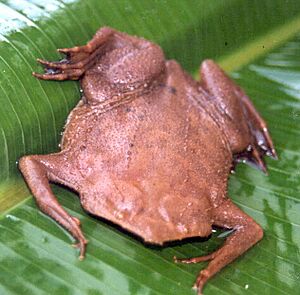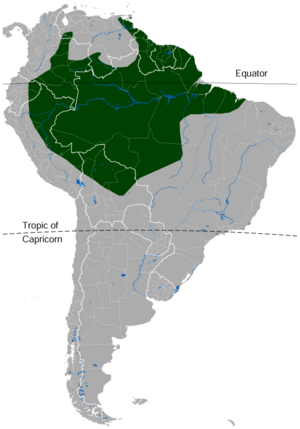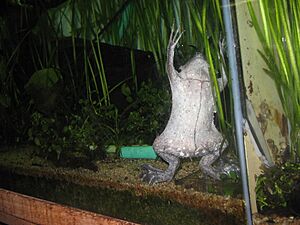Common Surinam toad facts for kids
Quick facts for kids Common Surinam toad |
|
|---|---|
 |
|
| Conservation status | |
| Scientific classification | |
| Genus: |
Pipa
|
| Species: |
pipa
|
 |
|
| Surinam toad range. | |
| Synonyms | |
|
|
The Surinam toad (Pipa pipa) is a special kind of frog. It lives only in water and is found across South America. This amazing toad is famous for how it raises its babies. The mother carries her eggs in small pockets on her back! After about 4 to 5 months, tiny froglets hatch directly from her skin. The Surinam toad is also a clever hunter. It waits quietly in the water for food to come close, then sucks it up quickly.
Contents
About the Surinam Toad
The Surinam toad is a frog that lives only in water. It is the biggest member of its family. This toad has a very flat body and a wide, flat, triangle-shaped head. It does not have a tongue. Its body looks a lot like a brown, mottled leaf, which helps it hide.
The toad's feet are widely webbed, like a duck's. Its front toes have small, star-shaped parts. Male toads can grow up to about 15.4 centimeters long. Females can be even bigger, reaching up to 17.1 centimeters. You can tell females apart by their length and a special ring-shaped area called a cloaca, which is visible when they are ready to lay eggs.
The skin of the Surinam toad is mostly light brown. It has some darker spots on its back. This coloring helps it blend in with its surroundings. Its nostrils are at the very end of its snout. Its eyes are very small, and it does not have an eardrum (called a tympanum). The toad's legs stick out to the sides, almost flat with its body. Its fingertips are shaped into four small lobes.
Since it has no tongue, the Surinam toad cannot catch prey like most other frogs. Instead, it uses a special suction method to grab its food.
Where Surinam Toads Live
The Surinam toad lives in slow-moving water. You can find it in streams, ponds, and pools in flooded forests. It often hides under leaves and other things that have sunk to the bottom. This toad has the largest habitat of all frogs in its family. It lives in many parts of South America, including Brazil and Ecuador. It is especially common in the Amazon rainforest.
The Surinam toad is so used to living in water that it can barely move on land. It would be quite helpless if it were out of the water.
What Surinam Toads Eat
The Surinam toad is an omnivore, meaning it eats both plants and animals. It is an ambush predator, which means it waits quietly for its food. Its diet mainly includes small water animals. These can be worms, insects, tiny crabs, and small fish.
Scientists have found different things in the stomachs of Surinam toads. These include small fish, other tiny Surinam toads, and even skin from other amphibians. One study showed that tiny crustaceans called Cyclopoida made up most of their diet. They also ate insect larvae and other water bugs. Finding skin fragments in their stomachs suggests that these frogs might eat each other or even their own shed skin. Eating shed skin is common among amphibians.
Because of what they eat, we know that Surinam toads are ambush predators. They will eat almost anything that falls into the water or that they find while looking for food.
How Surinam Toads Hunt
The Surinam toad has a very special way of catching food. It uses a unique "suction feeding" method. The toad opens its mouth wide and quickly sucks in a lot of water. This pulls the prey right into its mouth. It also uses its fingers to help guide the fish and stop it from escaping.
To create this suction, the toad can make its body bigger very quickly. It expands a special cavity inside its mouth and throat. This cavity can expand into the lower part of its body. All its important organs, like its heart and lungs, can move backward. This makes extra space for the cavity to get much larger.
When the cavity expands rapidly, it creates a strong negative pressure. This is like a vacuum. This vacuum sucks in the water and the prey. The fish are pulled into the toad's body. The toad then slowly lets the water out through its mouth. Its front legs stay near its mouth to make sure the prey doesn't get away. The Surinam toad might be the only animal with a backbone that can make its whole body bigger when it sucks in food.
The toad also uses its front legs to "scoop" prey into its mouth. Before catching food, its front legs are held in front of its head. When it catches prey, it stretches its legs out and pulls them towards its mouth. If it touches the prey, it grabs it and pushes it in. If not, the prey is just sucked in. These frogs are very skilled with their front legs compared to other frogs in their family.
How Surinam Toads Reproduce
Surinam toads usually mate during the fall and winter. Males make a sharp clicking sound to attract females. They do this by snapping a bone in their throats. The sound is like metal clicking. They click about four times per second, in bursts of 10 to 20 seconds.
After a male attracts a female, he grabs her front legs. This is called amplexus. The female's cloaca and skin start to swell. The pair then swims around in the water, flipping in arcs. They swim to the surface to breathe, then go back down. At the bottom, the male lies on his back with the female on top of him.
While they are mating, the female's back slowly swells up. Many eggs are then moved from the female's cloaca onto her swollen back skin. The eggs are about 6.5 millimeters wide. On the first day, the eggs sink into the skin. By evening, they are set into the female's back. After two days, most of the egg yolks are under the skin. Only parts of the jelly and outer membranes are visible.
The eggs stay in these pockets on the mother's back. The babies develop inside until they are fully formed toadlets. They do not hatch as tadpoles. They grow a tail while developing, but it's only temporary. It helps them get oxygen. After 12 to 20 weeks, the tiny toads hatch. They look just like their parents, but they are only about 2.5 centimeters long.
Once they hatch, the young toads usually live alone. After giving birth, the mother slowly sheds the thin layer of skin that held the eggs. Then, she can start the cycle again.
Mating Competition Among Males
When two male Surinam toads meet during the mating season, they might fight. They often press their snout close to the chest or throat of the other male. During the fight, both males make single clicks, similar to the sounds they use for breeding. If they make eye contact, they click very quickly.
After some time, they might go back to swimming, but they stay close. One toad might swim very close above the other, touching its rival with only its front legs. These fights can last a long time. Sometimes, one male bites the other, which usually ends the fight. However, a male that loses might not give up. He might even bother a breeding pair during reproduction.
Surinam Toad Conservation
The Surinam toad is currently listed as "Least Concern" by the IUCN. This means it is not in immediate danger of disappearing. However, its home is being lost and broken up. This is happening because of farms expanding and people moving into the Amazon rainforest.
Because of deforestation and human activity, these frogs have been found in places they normally wouldn't be, like on land. This shows how important it is to protect the habitats where these unique frogs live.
Surinam Toads in Aquariums
When kept in an aquarium, Surinam toads like to have plants and rocks to hide behind. They also prefer dim lighting. These toads produce a lot of waste, so their water needs to be changed often to keep it clean.
Cultural Importance
The poet Samuel Taylor Coleridge once wrote about the Surinam toad. He said his thoughts "bustle along like a Surinam Toad, with little toads sprouting out of back, side, and belly, vegetating while it crawls." This shows how unique the toad's way of raising babies is.
The Surinam toad is also often mentioned as something that can trigger trypophobia. This is a feeling of fear or disgust when seeing many small holes or bumps close together.
Images for kids







